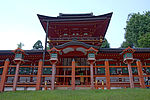Draft:Kasuga no Kami
| This is a draft article. It is a work in progress open to editing by anyone. Please ensure core content policies are met before publishing it as a live Wikipedia article. Find sources: Google (books · news · scholar · free images · WP refs) · FENS · JSTOR · TWL Last edited by Davemck (talk | contribs) 5 months ago. (Update)
Finished drafting? or |
 Comment: might be better to merge into Kasuga-taishaImmanuelle ❤️💚💙 (talk to the cutest Wikipedian) 23:45, 10 December 2023 (UTC)
Comment: might be better to merge into Kasuga-taishaImmanuelle ❤️💚💙 (talk to the cutest Wikipedian) 23:45, 10 December 2023 (UTC)
Kasuga no Kami (春日神) also known as Kasuga Gongen (春日権現) is a god of Kasuga Taisha.
He has five components
The four main kami enshrined at Kasuga-taisha are Ame no koyane, Himegami, Futsunushi no mikoto, and Takemikazuchi no mikoto.[1] Though these are the primary divine beings of Kasuga taisha, they are often grouped together as a syncretic, combined deity known as Kasuga Daimyōjin.[2] Kasuga Daimyōjin is composed of five divine beings and each consists of a Buddhist deity and Shinto kami counterpart. The fifth deity, Ame-no-Oshikumone, was added much later and is said to be the divine child of Ame no koyane and Himegami.[3] The importance of the multifaceted kami was that it became a template for future worshipers who wanted to combine several deities to pray to at once.[4]
Content taken from Himegami[edit]
Hiraoka Shrine is located in the western foothills of the Ikoma Mountains in central Osaka Prefecture. In its earliest days, it was a center for mountain worship and the kami of Kozudake, the peak immediately behind the shrine, came to be identified with Ame-no-Koyane, the tutelary deity of the Nakatomi clan, the ancestors of the Fujiwara clan. There is no documentary evidence of when the shrine was first constructed, but it is believed to be sometime during the Kofun period. When the Fujiwara built Kasuga Taisha in Nara, two of the four kami enshrined (Ame-no-Koyomi and Himegami) were bunrei transferred from this shrine, and the Hiraoka Shrine was thus given the name of Moto-Kasuga ("former Kasuga").[5][6]
The four main kami each have a shrine devoted to them which are all in the same architectural style. They are characterized by sloping gabled roofs, a rectangular structure, katsuogi (decorative logs), and chigi (forked roof structures).[7] The first hall established is dedicated to Takemikazuchi no mikoto, the second to Futsunushi no mikoto, the third to Amenokoyane no mikoto, and the final hall is attributed to the consort, Himegami.[8]
References[edit]
- ^ Grapard, Allan G. (1992). The protocol of the gods: a study of the Kasuga cult in Japanese history. University of California Press. ISBN 0520070976. OCLC 25873140.
- ^ Tyler, Royall (2016). The miracles of the Kasuga deity. Columbia University Press. ISBN 9780231534765. OCLC 954193203.
- ^ Ten Grotenhuis, Elizabeth (1999). Japanese mandalas : representations of sacred geography. University of Hawai'i Press. ISBN 0824820002. OCLC 39181008.
- ^ Ashkenazi, Michael (2011). Handbook of Japanese mythology. ABC-CLIO. ISBN 9781849728560. OCLC 755870995.
- ^ Yoshiki, Emi (2007). Zenkoku 'Ichinomiya' tettei gaido (in Japanese). PHP Institute. ISBN 978-4569669304.
- ^ Okada, Shoji (2014). Taiyō no chizuchō 24 zenkoku 'Ichinomiya' meguri (in Japanese). Heibonsha. ISBN 978-4582945614.
- ^ Cali, Joseph (2013). Shinto shrines: a guide to the sacred sites of Japan's ancient religion. University of Hawai'i Press. ISBN 9780824837136. OCLC 1043096844.
- ^ "Main Sanctuary". www.kasugataisha.or.jp. Archived from the original on 2019-06-24. Retrieved 2019-03-28.
- Kanji
- Kyōiku kanji
- [[:Category:This page will be placed in the following categories if it is moved to the [[WP:NS0|This page will be placed in the following categories if it is moved to the WP:NS0.
[[fr:Kasuga no Kami]][[ja:Kasuga no Kami]][[zh:Kasuga no Kami]] This is a Chinese character article that I am working on[1]. It needs to be bumped.]]

